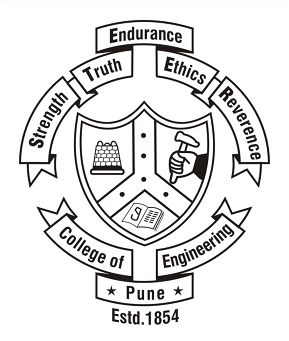College of Engineering Pune
| अभियांत्रिकी महाविद्यालय, पुणे | |
| Motto | Strength Truth Endurance |
|---|---|
| Type | Public |
| Established | 1854 |
| Chairman | Fakir Chand Kohli |
| Dean | Dr. M. S. Sutaone, Dean of Academics Dr. S. L. Patil, Dean of Student Affairs Dr. D. W. Pande, Dean R & D Dr. R. R. Joshi, Dean of Quality assurance Dr. M. J. Rathod, Dean of Alumni and International Affairs Dr. Vahida Attar, Controller of examination |
| Director |
Dr. Bharatkumar Bhagatraj Ahuja Deputy Director : Dr. B. N. Chaudhari |
|
Academic staff
|
20 |
|
Administrative staff
|
400 |
| Students | 3,800 |
| Undergraduates | 2,800 |
| Postgraduates | 1000 |
| Address |
Wellesly Road Shivajinagar Pune 411 005, Shivajinagar, Pune, Maharashtra, India |
| Campus | Urban, 36.81 acres (currently under demarcation for development purpose) |
| Website | www.coep.org.in |
Dr. Bharatkumar Bhagatraj Ahuja
College of Engineering, Pune (COEP) is an autonomous engineering institute affiliated to Savitribai Phule Pune University in Pune, Maharashtra, India. Established in 1854, it is one of the oldest engineering colleges in Asia, after College of Engineering, Guindy Chennai (1794) and IIT Roorkee (1847). The students and alumni of College of Engineering, Pune are colloquially referred to as COEPians. The college's study model was referred to, in the early 1950s, as the "Poona Model".
College of Engineering, Pune is located at the confluence of the rivers Mula and Mutha.
The college was one of the first few colleges established by the British to serve the Indian subcontinent. The foundation stone of the new college was laid by the Governor, Sir Bartle Frere, who was to become the Vice-Chancellor of the University, on 5 August 1865. In June of the following year, Theodore Cooke M.A., was appointed the Principal. He went on to hold the office for next 28 years.
Initially, It was started on December 16, 1854, to train public works department (PWD) officials and was housed in three bungalows as the ‘Poona Engineering and Mechanical School’ to train subordinate officers for carrying out public works like buildings, dams, canals, railways and bridges. In July 1857, Henry Coke was given the charge of the institute. Admission was open to all, irrespective of nationality or caste. Good proficiency in English and basic knowledge of Mathematics were a prerequisite for getting admitted to the institute. The process of admission required that the aspiring candidate apply to the nearest government English school, to whom the entrance examination papers were handed over. The headmaster would take the examination on a date deemed convenient to him and submit the answer sheets to Henry Coke, the in-charge of the mechanical school. After examining the papers, Coke would notify the headmaster of the school with the names of candidates who were deemed fit for admission. Scholarships of ₹6 were offered per month after a period of six months of training in the mechanical school for fifteen students. The courses offered included Mathematics, Drawing, Surveying and levelling, building and construction and setting out works on the ground. The course would run for a period of two years.
...
Wikipedia

